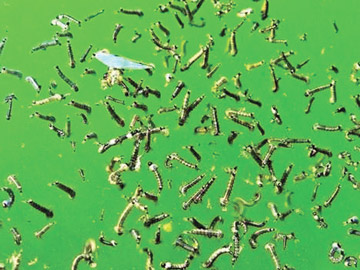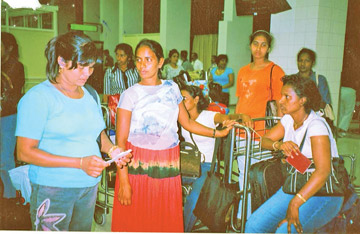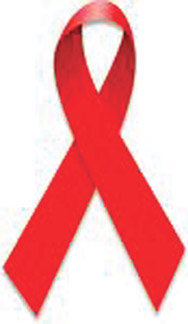|
HEALTH WATCH
Dengue: Killing the killer at large
Nadira Gunatilleke
We just ended the National Dengue Control Week. The time is 8.30 am.
I started to write this feature. But I cannot concentrate. Two or three
mosquitoes flying around me singing the deadly dengue song. I am writing
about dengue fever while chasing away the deadly (may be dengue)
mosquitoes! The mosquitoes are not from the Colombo city.
The city is now cleaner than ever, thanks to the armed forces. The
mosquitoes have come from one of our air conditioners or some such
internal hide outs ! My home and garden (located out of Colombo) is free
of mosquito breeding sites but still I am not safe. This is the pathetic
situation we are going to talk about today.
During the National Dengue Control Week ended some time back, the
health authorities found dengue mosquito larvae from 1015 state and
private institutions countrywide. How about the employees of those
institutions? How about their safety and health? This is something very
important that needs to be focused on. The total number of places found
with dengue mosquito larvae was 19525. This is an alarming number when
it comes to dengue which is deadly.
There were dengue mosquito larvae in 793 schools. It is the children
who suffer most from dengue. So how about the safety of the children who
study in those schools? Who takes the responsibility for their lives?
BTI or nothing will work without responsible citizens and accountable
land lords/heads of institutions.
This year 227 persons have already died from dengue while over 31800
persons affected. The number of deaths reported in August was 24 and it
was eight deaths in September. No deaths have been reported in the month
of October. It shows the success of the National Dengue Control Week and
the hard work done by armed forces, Presidential Task Force set up to
control dengue and the all the other mosquito related illness.
|

Larvae |
Only 623 dengue cases have been reported in October and the number of
dengue cases reported last month (September) was 1818. There were 4119
dengue cases in August. The highest number of dengue cases which is 5555
had been reported from the Colombo district. The number of dengue cases
reported from Gampaha district was 3684. There were 2662 dengue cases
reported from Ratnapura district.
What we talk about all the time? We talk about dengue, symptoms,
treatment, mosquitoes, cleaning mosquito breeding sites, etc. But there
are many important things that we never talk about. Now the time has
come to talk about such things. It is all about dengue fever. Here are
some facts that did not catch much attention so far. Basic information
about dengue fever, symptoms and prevention can be found in everywhere.
Therefore it is useful to pay attention to the facts that not
highlighted so far.
According to the Media Coordinator to the Health Ministry, W M D
Wanninayake, when a person get fever, he or she needs to seek medical
treatment without any delay. It is better to seek medical treatment from
a state hospital or a Government dispensary. This is because such
institutions have a proper follow up program for suspected dengue
patients. Seeking medical treatment early from a state hospital is
vital. All essential life saving drugs are now freely available at state
hospitals to treat dengue patients.
Wanninayake pointed out the importance of cleaning hidden mosquito
breeding sites such as fallen tree leaves, especially the parts of
banana trees and similar trees. Live trees like banana trees also holds
clean water which is the breeding ground of dengue mosquitoes. In some
houses tables are being kept on small water pots in order to prevent
ants climbing to the table.
These water pots are another good place to breed dengue mosquitoes.
Dengue larvae can survive in a dry environment for a period of one year.
Even after one year these larvae can produce dengue mosquitoes when they
receive water. This shows the danger of keeping unclean surroundings.
Last year Ratnapura district hit by Chikungunya, another type of fever
caused by mosquitoes. It was discovered that gem mines scattered all
over Ratnapura district created excellent mosquito breeding grounds.
|

Getting rid of mosquitoes |
This shows the attitude of people. They are only interested in
digging the valuable gem stones and selling lands to dig mines but
nothing else. Here the people have totally ignored their responsibility.
But at the end all blame the Government!
Sri Lanka is about to eradicate Malaria. Sri Lanka has almost
eradicated Malaria and no Malaria deaths have been reported from Sri
Lanka during last three years. It is also resulted in an unprecedented
99 percent of decrease in the reported Malaria burden during the last
ten years. This is the latest situation about Malaria in Sri Lanka and
it shows how good Sri Lanka is doing when it comes to controlling
Malaria.
The other important fact is, 35 percent of the dengue patients are
women and 25 percent of them are school children which means they had
been infected when they are at home or school. The dengue mosquito can
fly only 500 meters.
According to the World Health Organization (WHO), Dengue is
transmitted by the bite of an Aedes mosquito infected with any one of
the four dengue viruses. It occurs in tropical and sub-tropical areas of
the world. Symptoms appear three to 14 days after the infective bite.
Dengue fever is a febrile illness that affects infants, young children
and adults.
Symptoms range from a mild fever, to incapacitating high fever, with
severe headache, pain behind the eyes, muscle and joint pain, and rash.
There are no specific antiviral medicines for dengue. It is important to
maintain hydration. Use of acetylsalicylic acid such as aspirin and non
steroidal anti-inflammatory drugs such as Ibuprofen is not recommended.
Dengue hemorrhagic fever (fever, abdominal pain, vomiting, bleeding)
is a potentially lethal complication, affecting mainly children. Early
clinical diagnosis and careful clinical management by experienced
physicians and nurses increase survival of patients.
Medically unexplained symptoms
A burden to individual, family and health services:
Dr SHANTHA HETTIARACHCHI
He had come to seek advice for his unresolved physical feelings of
numbness, body aches lasting for over an year. An unhappiness and
hopelessness could be seen very clearly on the face of this middle aged
gentleman.
|

Patient awaiting doctor’s diagnosis |
He was not feeling well for several months. A lady accompanied him.
After a few minutes silence they disclosed incidents in the recent past
that changed their life.
He was a father of a little child and was living with his wife. The
lady, who accompanied him was not his wife but met him fifteen months
back. According to her, he had got those manifestations, just three
months after starting their relationship.
He was keeping a file of medical investigations and prescriptions
written by different doctors during this period. No abnormalities were
noted in medical investigation reports. No abnormal signs, detected on
physical examination either but he looked like a patient with many
ailments.
This story is a common occurrence, reported worldwide today. There is
a difficulty in categorizing or listing the relevant clinical entity,
under the heading of physical illness or mental illness. Therefore it
has been named as Medically Unexplained Symptoms in the field of
medicine.
Such manifestations are defined as medically unexplained when the
clinical presentation is incompatible with a known physical illness with
the absence of relevant physical signs and laboratory investigations,
supporting a diagnosis of a physical illness.
Today, this medical entity is responsible for psychological and
financial burden to an individual and the family. As people with
medically unexplained symptoms are representing a major proportion of
out patient clinic attendees that it has become a major burden to the
free health services of the country.
The expenditure on care, treatment and repeated investigations are
up, while these people are attending different clinics at different
health institutions without getting a satisfactory answer to their
problem. It has lead to over utilization of services and
disproportionate consumption of resources especially in the public
sector. They come with chest pain, abdominal pain, bloating or cramp,
pain in the limbs or joints, headache, backache, shortness of breadth,
numbness or burning sensation of the body, loss of appetite, fatigue,
faint feeling or lifelessness.
Doctors’ Wives Association Sri Lanka 25th Anniversary
Doctors Wives Association Sri Lanka will be celebrating their 25th
anniversary on Sunday October 31st at 7 pm at the Galle Face Hotel.
The Association President Chrissy Aloysius told the Health Watch -
key figure in organizing this Association 25 years ago - said that so
far Sri Lanka remains the only country in the world where doctors’ wives
have got together to form a Doctors’ Wives Association.
EA
Entire From Parliment For Medical Crossword No:43
Edward Arembewela
For the first time Health Watch received two entries from Parliament
staff in Kotte for the Medical Crossword No 43.
* Both entries have been sent by Parliament Officer Dharmapriya
Rajapakse.
* Among other entries received so far is one from a doctor, Dr.
Vasantha Velumylum 63 yrs from No 20 2/1, Palmyrah Court, Palmyrah
Avenue, Colombo 3.
* This is a health education crossword and this is the first time we
have received an entry from a very senior doctor.
* The grid of the crossword is prepared by Dr Kelum Palpola of Lanka
Hospital, former Apollo, Narahenpita, Colombo.
* The Crossword is sponsored by the Wish Institute, Delkanda,
Nugegoda.
Preventing HIV in Women
Presidential Address 2010 College of Venereologists :
Dr CHANDRKA WICKRAMASOORIYA Consultant Venereologist
Working in the Central STD Clinic in Colombo which is the central
clinic of the National STD/AIDS Control Program where most of the HIV
positive cases in the country are detected, managed and reported, my
observations over the last 10 years prompted me to talk on this topic
today mainly because the number of women and children detected with HIV
are increasing.
By the end of September 2010, 506 women with HIV were diagnosed and
46 children were born with HIV. Although the numbers are small, this may
be only the tip of the iceberg.
|

Sri Lankan migrant workers |
To date, 26 of 46 children with HIV have survived and 15 are on anti
retroviral medicine. The availability of anti-retroviral therapy (ART)
prolongs their lives and improves their physical quality of life, but
the social and psychological problems they will have to face cannot be
compensated for by medical management alone.
We as health care providers can play an active role in preventing HIV
in children. ‘We need to protect women to protect children.’ The need to
protect women from HIV is not only to protect children but also to the
reduce the serious impact of HIV on the lives of women themselves. Women
with HIV are:
* Often stigmatized and blamed for causing HIV/AIDS and other STDs.
* Dismissed from their jobs or not hired, Evicted from their homes,
abandoned by their husbands or other long-term partners, and denied the
custody of their children.
* Sometimes pressured not to become pregnant or to be sterilized, or
if they are already pregnant, to terminate their pregnancies. Being the
caregivers of families, when their health fail the families get affected
badly
HIV in women: the global situation
Even 28 years after the onset of the epidemic HIV infection still
continues to remain a serious public health problem affecting women. For
the past two decades, HIV infection has affected women worldwide, more
than any other life-threatening infectious disease. Women who were at
the periphery at the beginning of the epidemic in 1980s are at the
centre of concern today.
Currently women account for 50 percent of the estimated 33.4 million
people living with HIV globally.
This proportion varies from 27 percent in the Region of the Americas,
35 percent in the Region of Asia, to as much as 58 percent in the
African Region. For young women, the figures are even more alarming.
Globally, 75 percent of young people infected with HIV are women and
girls. Even after implementation of preventive measures for more than 28
years, in 2008 of the estimated 7400 new infections a day 97 percent
were in low and middle-income countries. Of the 6200 new infection among
adults 48 percent are among women.
What is the situation in Asia ?
A total 4.7 million adults are living with HIV in Asia, of them,
women account for 35 percent. India contributes to the bulk of the HIV
burden in Asia. Of an estimated 2.4 million HIV infections in India,
women account for 39.3 percent of the infections.
The epidemic in the South-East Asia Region has grown alarmingly.

Today, HIV has been reported from 10 of 11 countries in the Region
(except North Korea). Of the estimated 3.5 million people living with
HIV/AIDS in the Region, women account for 33 percent of the total.
Five countries account for the majority of HIV infections - India,
Indonesia, Myanmar, Nepal and Thailand. Bangladesh, Bhutan, Maldives,
Sri Lanka and Timor-Leste together represent less than 1 percent of the
total HIV burden in the Region.
What is the situation in Sri Lanka ?
At the end of September 2010, a cumulative total of 1,285 HIV cases
were reported to the NSACP, of which 767 were men and 518 women; 46 were
children. The main mode of transmission was due to unprotected sex
between men and women (82.8 percent). Men who have sex with men
accounted for 11.2 percent of the transmission, while mother-to-child
transmission accounted for 5.4 percent. Transmission through blood and
blood products was only 0.4 percent. However, the percentage of HIV
infected women has increased over the last three decades.
Profile of HIV infected women in Sri
Lanka
Most infections were seen between the ages of 30 and 44 years.
This pattern has persisted for the last three decades.
However during past few years the number detected in the 20-30 year
group has also increased. This is a matter of grave concern.
Is this an indication that young people are getting infected in spite
of the many preventive activities carried out during last three decades
due to programs not being targeted at this group?
Probable source of infection
Available data indicate that 67 percent women had sexual
relationships only with a single partner ( either the marital partner or
a single stable partner) 20 percent with a casual partner, 11 percent
had more than one male partner and 4 percent had sex with their clients
.
Similar situations have been reported in other countries. More than
40 percent of new infections in Cambodia and Thailand were among women
whose only sexual partner was their husband.
A study in India found that 90 percent of the HIV infected women were
married and their only sexual partner was the husband. This reflects how
sexual subordination makes women vulnerable to HIV.
In many societies, there is a significant power differential between
men and women, which is supported by social and cultural systems giving
the control to males.
Males are expected to initiate relationships. Sexual assertiveness in
women is unacceptable and often stigmatized. Even in countries that
promote monogamy and mutual fidelity, and discourage multiple casual
partners as a societal norm only women are expected to adhere strictly.
This raises the question of reliance on monogamy or mutual fidelity
as a principal solution for HIV prevention, as this can be misleading to
some women, because fidelity protects against HIV/AIDS only if it is
completely mutual and life-long.
To be continued |



